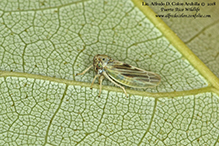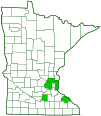leafhopper
(Agalliopsis ancistra)
Conservation • Description • Habitat • Ecology • Distribution • Taxonomy
|
|
||||||||||||||
Description |
Agalliopsis ancistra occurs throughout North America but is most common in the northeast. It is uncommon in Minnesota. Females are ⅛″ to 3 ⁄16″ (4.0 to 4.3 mm) long, males a little smaller, ⅛″ (4.5 mm) long. The body is flattened laterally and tapered, appearing somewhat wedge-shaped from above. Adults are usually greenish in front fading to brown in the back. The head is about as wide as the exoskeletal plate covering the thorax (pronotum). The upper surface of the head (vertex), the only part visible when viewed from above, is greenish and narrow. It is shaped like a parentheses, rounded in front and back, and only slightly narrower in the middle than at the sides. On the back of the head is there is a short sinuous curve behind each compound eye. There are two large compound eyes and two tiny simple eyes (ocelli). There are six distinct but small black spots on the head, four on the crown, two on the face between the compound eyes (on the frons). The face, not visible from above, is brown. The antennae are short and bristle-like. The pronotum is greenish with two small but distinct black spots, and a narrow, sometimes diffuse, longitudinal line in the middle. The spots are noticeably smaller than other leafhoppers in this genus. The plate between the wing bases (scutellum) is large, triangular, and yellow. There is a dark brown triangular mark in each corner at the base and a pair of small spots in the middle. The markings are variable in size and more or less diffuse, sometimes covering all of the scutellum except for a narrow yellow V shape at the tip. There are two pairs of wings, and they are held tent-like, almost vertically over the body when at rest. The forewings (hemelytra) are thickened, are longer than the body, and completely cover the sides of the body. They are greenish in front and fade to brown toward the tip. The hemelytra are comprised of a narrow area (clavus) behind the scutellum when the hemelytra are closed; and the remaining, broad, marginal area (corium). There are two paired dark brown spots on the clavus, separating the green at the base from the brown at the tip of the clavus. The veins are pale and distinct. The hindwings are thin, membranous, a little shorter than the hemelytra, and concealed beneath the hemelytra. The legs are yellow. The fourth segment (tibia) of each hind leg has two rows of comb-like spines. The last part of the leg (tarsus), corresponding to a foot, has three segments. The claws at the tip of the last segment are dark brown. Some individuals are mostly brownish but retain some greenish on the vertex and have greenish borders around the pronotal spots. |
Size |
Total length: ⅛″ to 3 ⁄16″ (3.5 to 4.3 mm) Male: ⅛″ (3.5 to 4.0 mm) Female: ⅛″ to 3 ⁄16″ (4.0 to 4.3 mm) |
Similar Species |
Habitat |
Grassy and shrubby areas, forest edges |
Ecology |
Season |
April through September |
Behavior |
Adults are attracted to light. |
Life Cycle |
|
Nymph Food |
|
Adult Food |
Plant juices from the leaves of alfalfa, clover, and other herbaceous plants |
Distribution |
||
|
Sources |
|
| 7/8/2025 | ||
Occurrence |
||
|
||
Taxonomy |
|
Order |
Hemiptera (True bugs, Hoppers, Aphids, and Allies) |
Suborder |
Auchenorrhyncha (true hoppers) |
Infraorder |
Cicadomorpha (spittlebugs, cicadas, leafhoppers and treehoppers) |
Superfamily |
Membracoidea (leafhoppers and treehoppers) |
Family |
|
Subfamily |
Megophthalminae |
Tribe |
Agalliini |
Subtribe |
Agalliina |
Genus |
Agalliopsis |
Subordinate Taxa |
|
|
|
Synonyms |
|
|
|
Common Names |
|
This species has no common name. The common name of the family Cicadellidae is leafhoppers, and it is applied here for convenience. |
|
Glossary
Corium
The thickened basal portion of the front wing that lies between the clavus and the membrane of insects in the family Hemiptera. Plural: coria.
Frons
The upper front part of an insect’s face, roughly corresponding to the forehead.
Hemelytron
The forewing of true bugs (order Hemiptera), thickened at the base and membranous at the tip. Plural: hemelytra.
Ocellus
Simple eye; an eye with a single lens. Plural: ocelli.
Pronotum
The exoskeletal plate on the upper side of the first segment of the thorax of an insect.
Scutellum
The exoskeletal plate covering the rearward (posterior) part of the middle segment of the thorax in some insects. In Coleoptera, Hemiptera, and Homoptera, the dorsal, often triangular plate behind the pronotum and between the bases of the front wings. In Diptera, the exoskeletal plate between the abdomen and the thorax.
Tarsus
On insects, the last two to five subdivisions of the leg, attached to the tibia; the foot. On spiders, the last segment of the leg. Plural: tarsi.
Tibia
The fourth segment of an insect leg, after the femur and before the tarsus (foot). The fifth segment of a spider leg or palp. Plural: tibiae.
Vertex
The upper surface of an insect’s head.
Visitor Photos |
||
Share your photo of this insect. |
||
This button not working for you? |
||
Alfredo Colon |
 |
MinnesotaSeasons.com Photos |
||
|
||
|
||

Slideshows |
|

Visitor Videos |
||
Share your video of this insect. |
||
This button not working for you? |
||
|
Other Videos |
||
|

Created: 1/25/2019 Last Updated: © MinnesotaSeasons.com. All rights reserved. |


